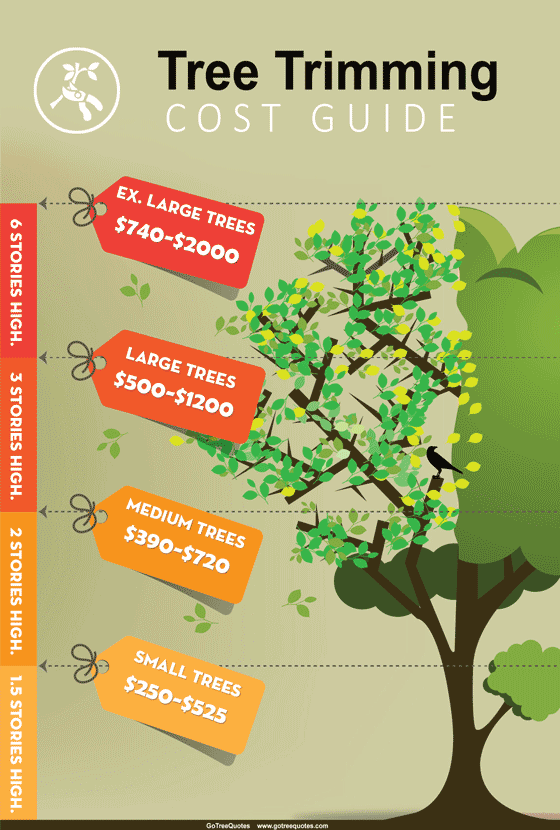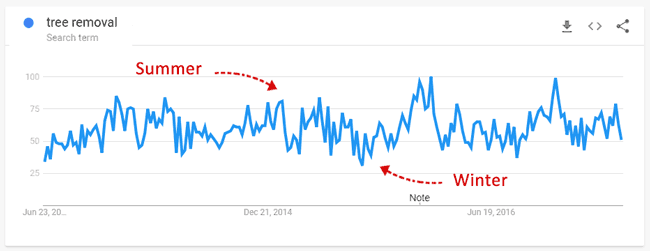Got a tree hanging a bit too close to your roof, or maybe those branches are crowding out your garden? Tree trimming is more than just cleaning up—it’s about keeping your trees safe, healthy, and looking great.
At Go Tree Quotes, we make finding a reliable, certified arborist easy, so you get top-quality service without the guesswork or hassle.
Whether it’s a small spruce or a big old oak, we’ve got you covered with the best in the business.
Tree trimming costs can range based on the size of the tree, the location, and how tricky the job is. Here’s a straightforward guide on what to expect when it’s time to trim back those branches.
What we cover
ToggleAverage Cost of Tree Trimming
Tree trimming costs range from $275 to $2,200, depending on your tree size and the job specifics. Here’s a quick breakdown:
| Tree Size | Average Cost Range |
|---|---|
| Small Trees (15–20 ft.) | $275–$578 |
| Medium Trees (20–30 ft.) | $430–$790 |
| Large Trees (30–50 ft.) | $550–$1,320 |
| Extra-Large Trees (50–100 ft.) | $814–$2,200 |
| Average Cost | $869.63 |
The smaller and simpler the job, the lower the cost, but big, complex projects with trees near buildings or power lines will cost a bit more.
Pro Tip: Winter is generally cheaper for trimming since it’s the off-season, so you might catch a better deal.

Key Factors Influencing Tree Trimming Costs
Tree trimming isn’t a one-size-fits-all job. Here’s what affects the cost:
- Tree Size and Type: Big trees like oaks or maples need more labor, time, and care, so they’ll usually cost a bit more to trim.
- Tree Health and Condition: Diseased or deadwood needs extra care and specialized tools, so these jobs often come with a slightly higher price tag.
- Location and Accessibility: Trees close to buildings, fences, or tough-to-reach spots cost more since they require additional equipment or time.
- Time of Year: Winter is the slow season for tree trimmers, so rates often drop a bit.
- Obstacles Around the Tree: Fences, power lines, or nearby structures can complicate the job and add to the overall cost.
- Number of Branches: Denser trees with a lot of branches take longer to trim, which means a bit of an uptick in cost.
- Tree Species: Different tree species need different techniques, so a palm tree’s needs will differ from an oak or a pine, affecting time and price.
Cost of Palm Tree Trimming
Palm trees are a whole different story when it comes to trimming. For a group of 10 palm trees of the same size that need trimming, you would expect to pay between $385 and $715.
Costs will depend on the height of the palms and how accessible the location is for the tree trimming service.
We can set you up with an arborist who knows how to handle palms for the best results.
Tree Trimming vs. Tree Pruning
Wondering if you need trimming or pruning? Trimming is usually for shaping and safety, like clearing branches away from your roof, while pruning focuses on tree health, removing deadwood and disease to keep the tree growing strong.
Not sure what’s best? Go Tree Quotes can help you find the right service for your trees.




Breakdown of Tree Trimming Services and Costs
Different types of trimming have different price tags. Here’s what you might expect:
| Service | Description | Average Cost Range |
|---|---|---|
| Basic Pruning | Involves trimming dead, diseased, or overgrown branches to improve tree health and shape. | $175–$1,800 |
| Root Pruning | Selective cutting of roots, often to prepare for transplanting or to control growth near foundations. | $300–$750 |
| Tree Topping | Removes the uppermost branches to reduce tree height drastically, though it may risk long-term damage. | $325–$1,100 |
| Crown Reduction | Trims outer branches of the canopy to reduce height and spread, keeping large trees in check near structures. | $200–$1,900 |
| Shrub and Bush Trimming | Shapes and tidies shrubs and bushes, removing overgrowth to improve appearance and health. | $50–$850 |
| Hedge Trimming | Precise cutting that enhances aesthetics and encourages thicker, healthier hedge growth. | $150–$1,100 |
For emergency services, prices vary based on urgency and complexity. Examples of emergencies include storm-damaged trees and fallen trees blocking views that pose immediate risks.
DIY vs. Professional Tree Trimming Costs
Thinking of handling the trimming yourself? DIY is fine for minor trims, but larger trees are better left to the pros.
Only certified arborists have the equipment and expertise to get the job done safely and efficiently.
| Option | Pros | Cons |
|---|---|---|
| DIY Tree Trimming | - Cost Savings: Lower costs, especially for small trees or shrubs. - Immediate Control: Trim at your own pace. - Learning Opportunity: Gain experience with tree care. | - Limited Reach: Difficult and unsafe to access high branches without professional equipment. - Injury Risk: High risk of injury without proper tools and training. - Potential Tree Damage: Incorrect techniques may harm the tree's growth. - Waste Disposal: Cleanup and disposal of branches are the homeowner’s responsibility. |
| Professional Tree Trimming | - Safety: Trained arborists manage high branches and complex jobs safely. - Quality of Work: Professionals use proper techniques for each tree type, promoting tree health. - Time-Saving: Faster and more efficient, especially for large trees. - Comprehensive Service: Includes cleanup and debris disposal, leaving your yard clean. - Insurance Coverage: Covers accidental damage or injury. | - Higher Cost: Professional services are more costly, with prices based on tree size and job complexity. - Scheduling Needs: Requires booking, which can delay work during peak seasons. |
Go Tree Quotes can connect you with experienced arborists who’ll do the job right, plus they also clean up afterward, leaving your yard mess-free.
Seasonal Timing and Optimal Trimming Times for Tree Care
Looking to save on tree trimming? Timing is key. Winter is often the best time to schedule trimming because demand is lower, which can mean lower prices. During winter, many trees enter a dormant phase.
This not only makes trimming more affordable but also healthier for the tree. Trimming while trees are dormant reduces stress, minimizes sap loss, and allows for stronger regrowth when spring arrives.
Each tree type has its own ideal timing for trimming, and Go Tree Quotes’ arborists are skilled in knowing these growth cycles.

Eco-Friendly Tree Trimming Practices
If you’re aiming for eco-friendly tree care, there are several sustainable practices to consider that protect your landscape and benefit local wildlife and the environment. Here’s how you can make your tree trimming as green as possible:
- Recycle Trimmings as Mulch
Instead of hauling away branches and leaves, consider using the trimmings as mulch. Mulching helps retain soil moisture, reduces weeds, and slowly releases nutrients back into the earth. - Coordinate with Wildlife Seasons
Schedule trimming around wildlife nesting and breeding seasons to avoid disturbing birds, squirrels, and other animals. For most trees, the best time to trim in harmony with wildlife is in late fall or winter when nests are empty. - Selective Trimming for Plant Health
Rather than over-trimming, opt for selective pruning that removes only what’s necessary for tree health and safety. - Compost Trimmings for Soil Health
Composting tree trimmings enriches your soil and reduces waste, transforming organic matter into a natural fertilizer. - Support Native Plant Growth
When planning your landscape, incorporate native species that support local ecosystems. Native plants require less water, adapt better to local conditions, and attract native wildlife.
Choosing eco-friendly practices benefits your yard’s appearance, enhances soil health, and fosters a thriving local ecosystem.
Go Tree Quotes supports these options and can connect you with arborists skilled in sustainable tree care practices.
Why Choose Go Tree Quotes for Tree Trimming Services?
At Go Tree Quotes, we make finding top local arborists easy. With over a decade of experience, we connect you with licensed, insured professionals who keep your trees in shape.
Our free quoting tool helps you compare prices from trusted local services, ensuring you get the best care for the best price.
Get Free Tree Service Quotes in Three Simple Steps
Comparing quotes is easy and free! We do thorough checks on each service to ensure quality.
- Enter your postcode and job details on our form.
- Your request is sent to three vetted tree services, who will contact you to quote.
- Review your three quotes and pick the best one without obligation.
Enjoy expert advice, fair pricing, and a stress-free experience!
FAQ's
Most trees benefit from trimming every 3-5 years, though the exact timing depends on the species and growth rate.
Regular trimming keeps your trees healthy, helps manage growth, and prevents safety issues.
You can avoid major overhauls and save in the long run by keeping a regular schedule.
You can handle minor trimming yourself, especially on smaller trees. However, large or hard-to-reach trees require professional expertise to prevent injury and promote healthy regrowth.
Arborists have the training and tools for a safe, thorough job, so DIY is best kept to smaller, simpler tasks.
When done right, trimming actually benefits the tree by removing dead or diseased branches, allowing it to focus on healthy growth.
Certified arborists know how to trim without harming the tree’s structure, keeping it strong and resilient.
Proper care promotes long-term health, making trimming a must for well-maintained trees.
Tree trimming appointments usually last between 1 and 4 hours, depending on the size and complexity of the job.
Small trees might only take an hour, while large trees with complex trimming needs can take longer. Multiple trees or tricky access will add time to the job.
The best time to trim is usually in winter when trees are dormant. This minimizes stress on the tree and promotes healthier regrowth in spring.
Some trees may benefit from trimming at other times, but winter is generally a safe bet for most species.










